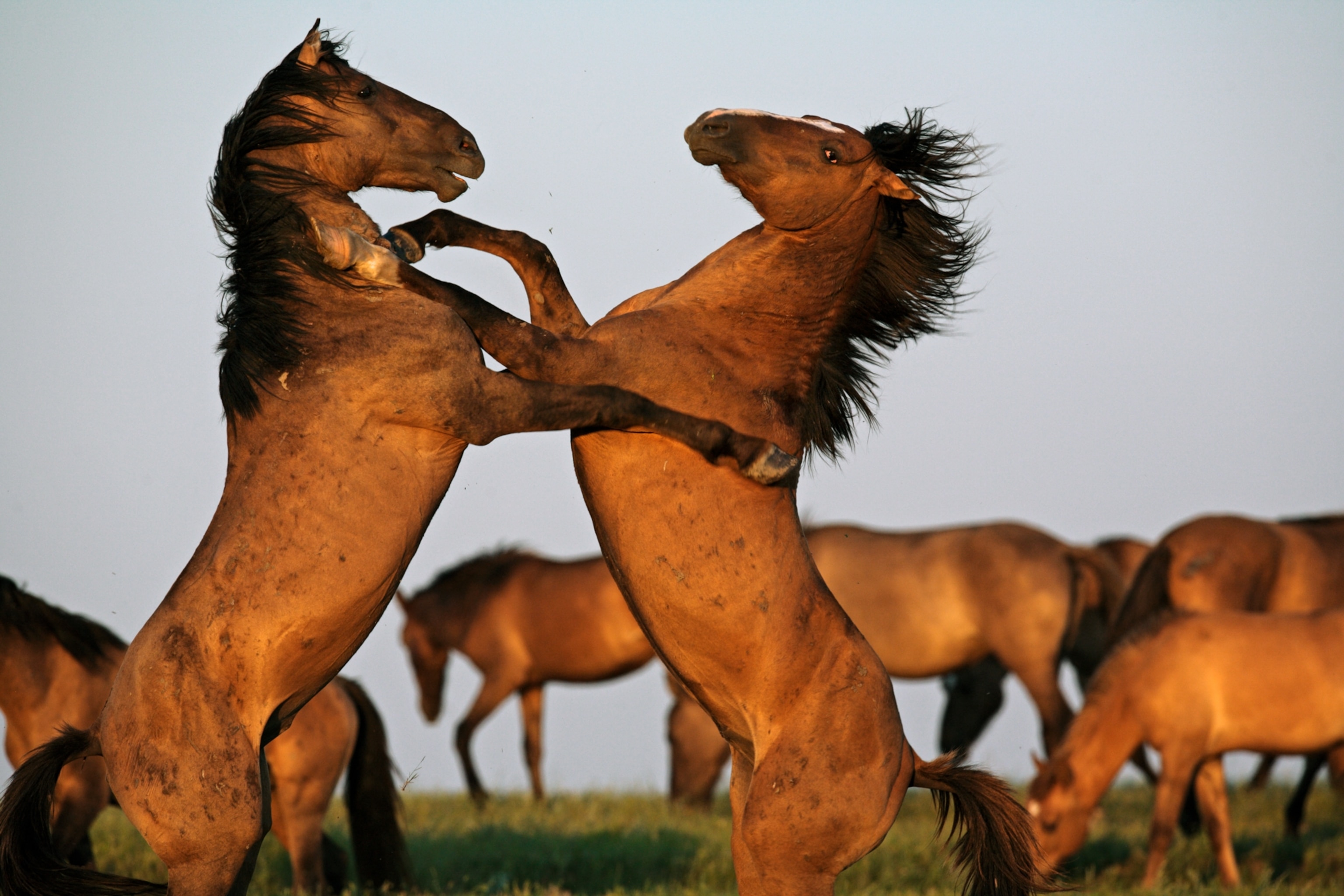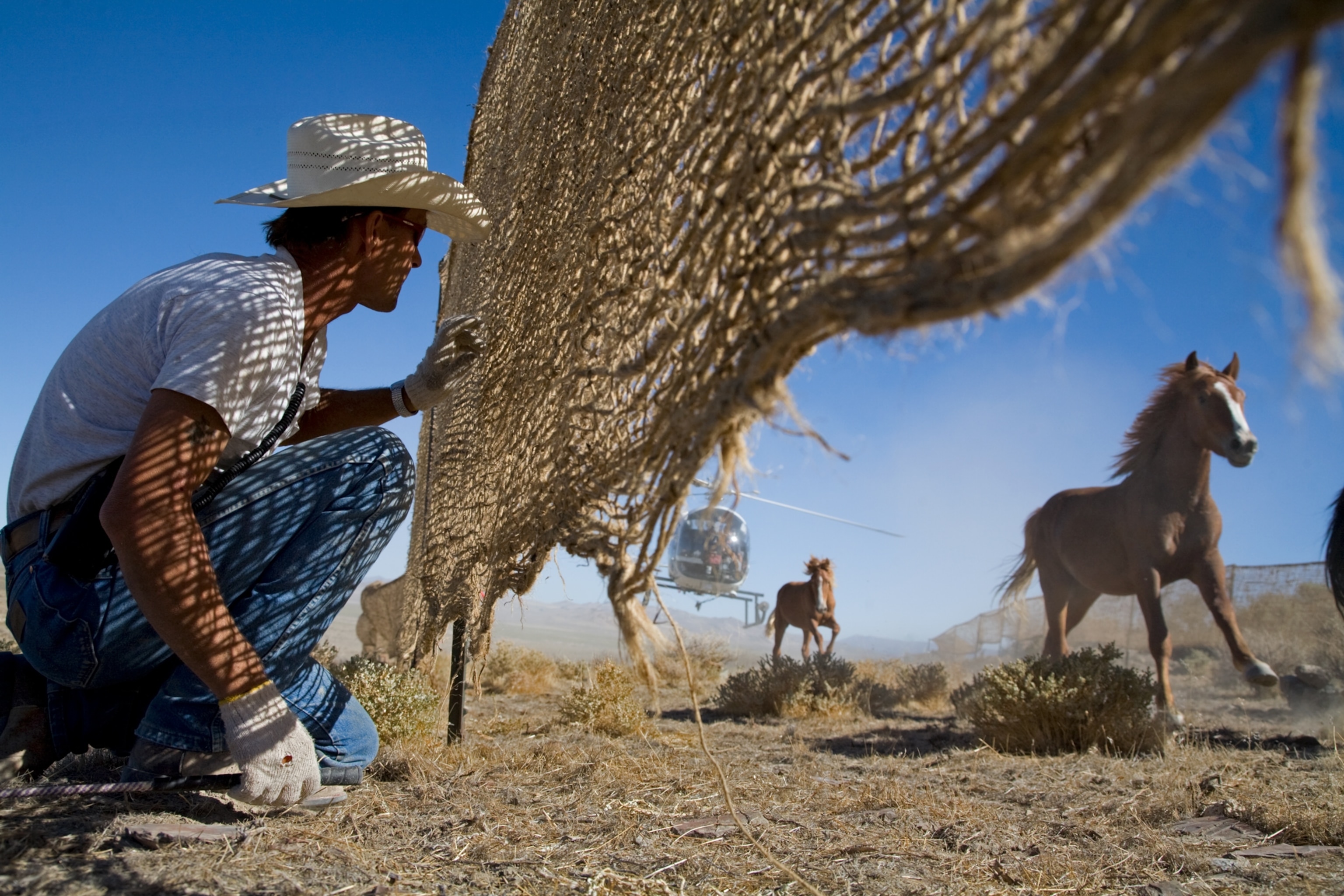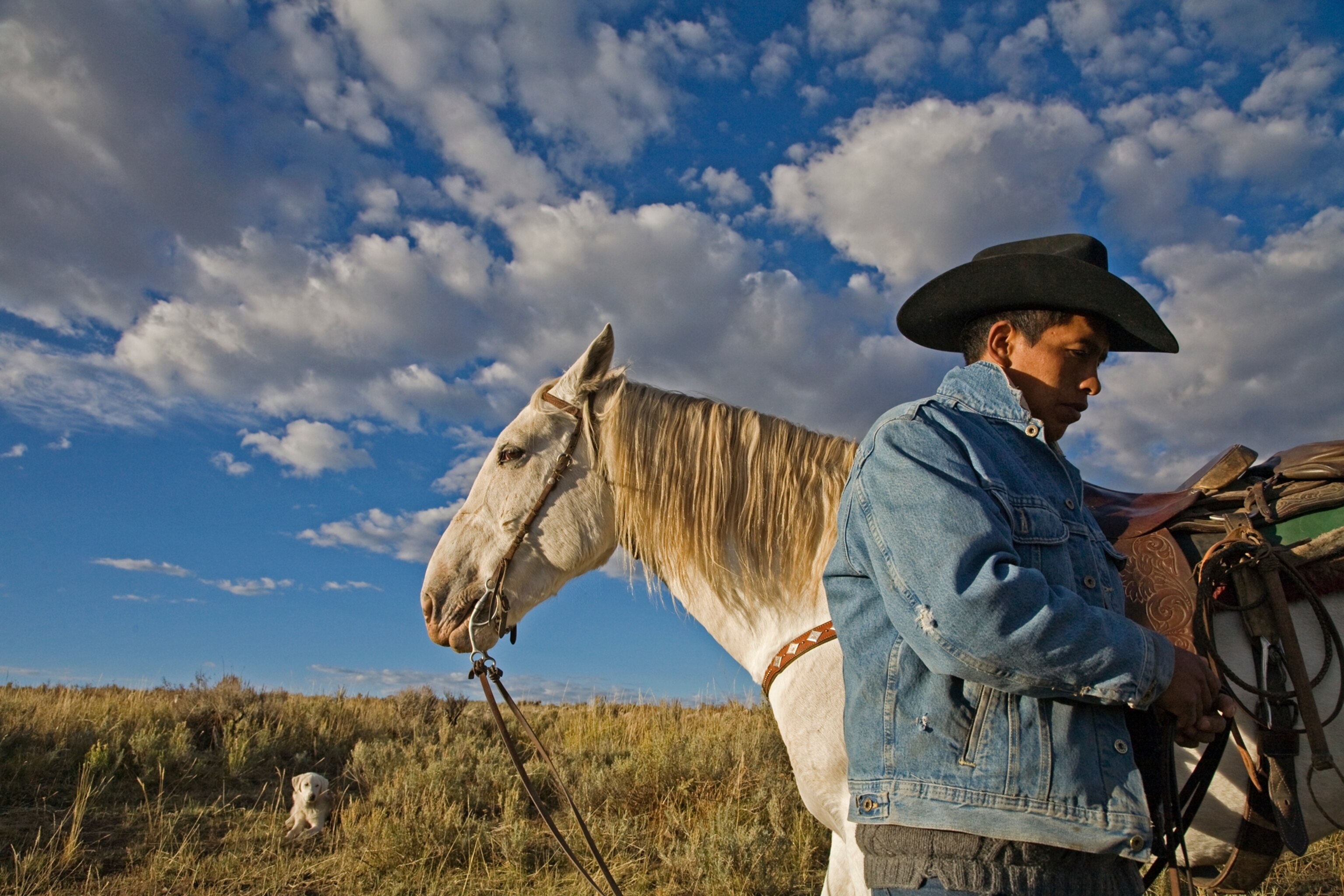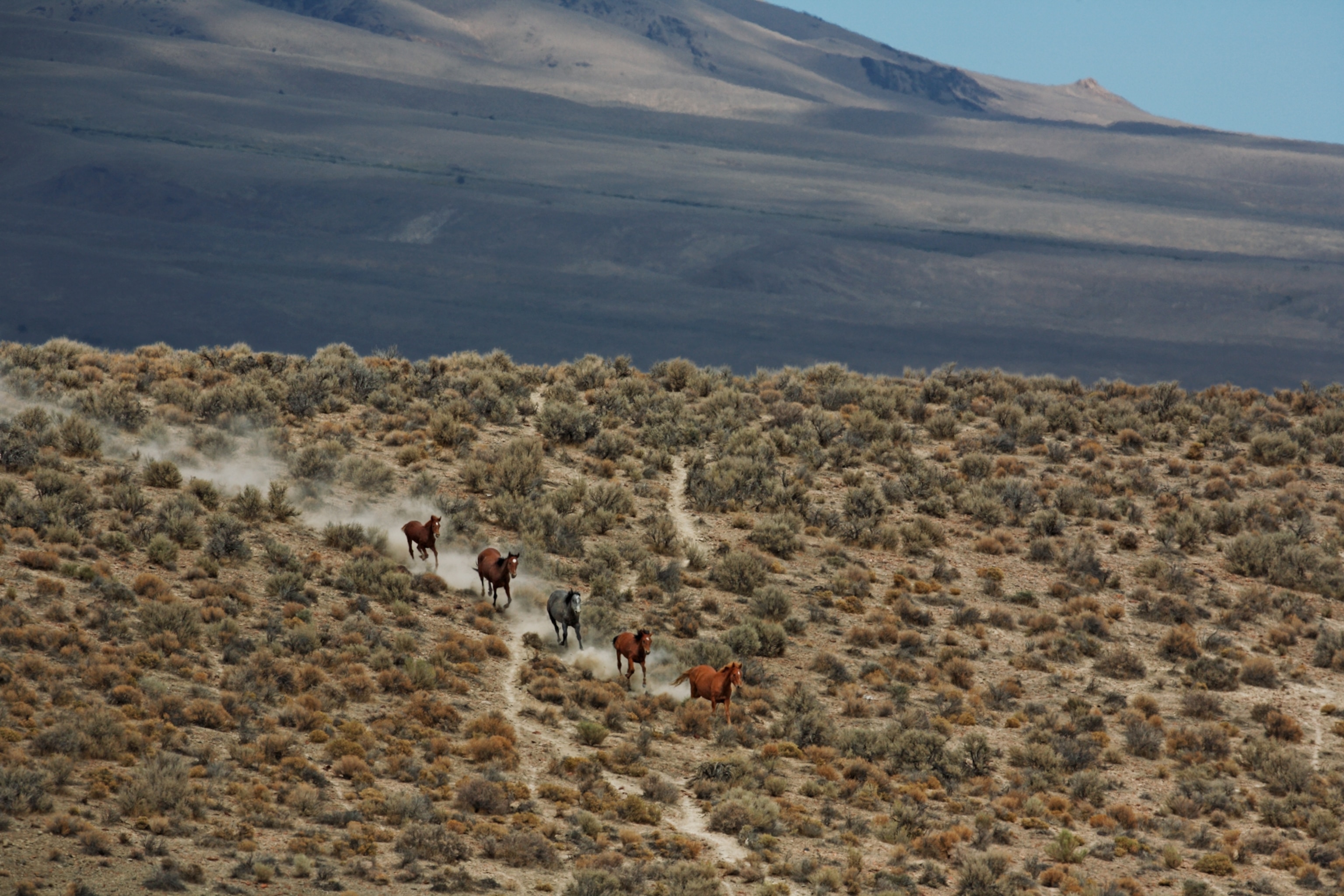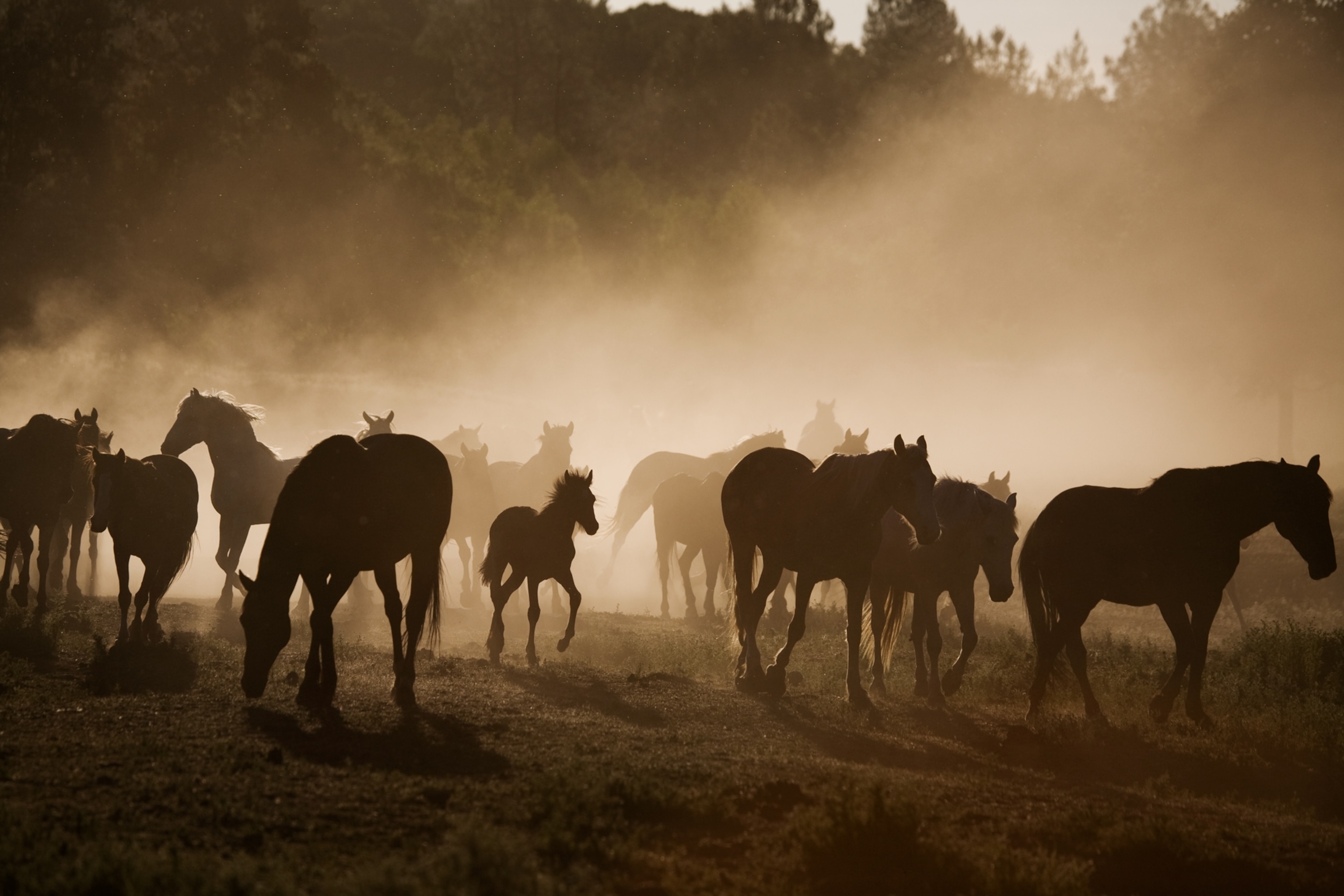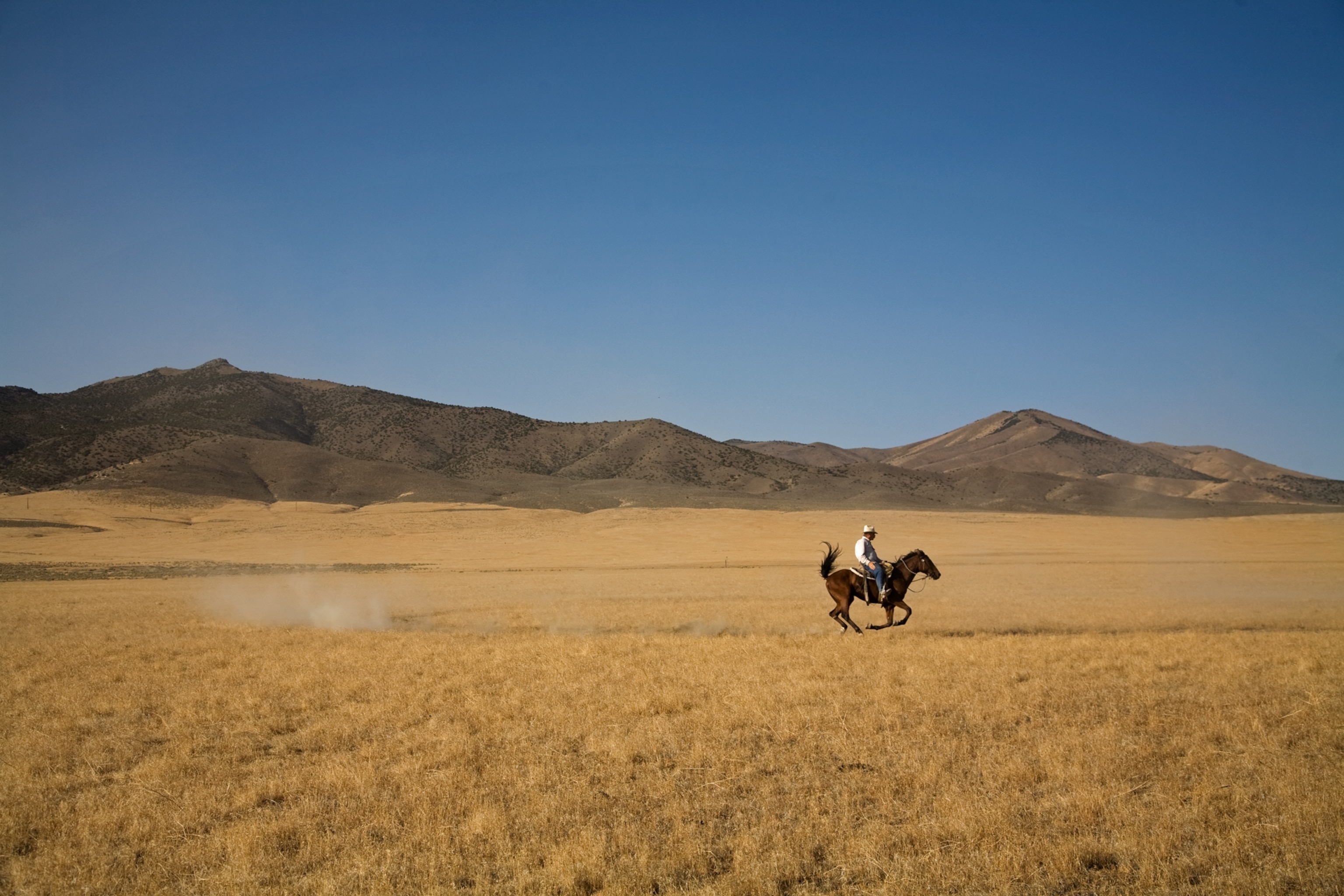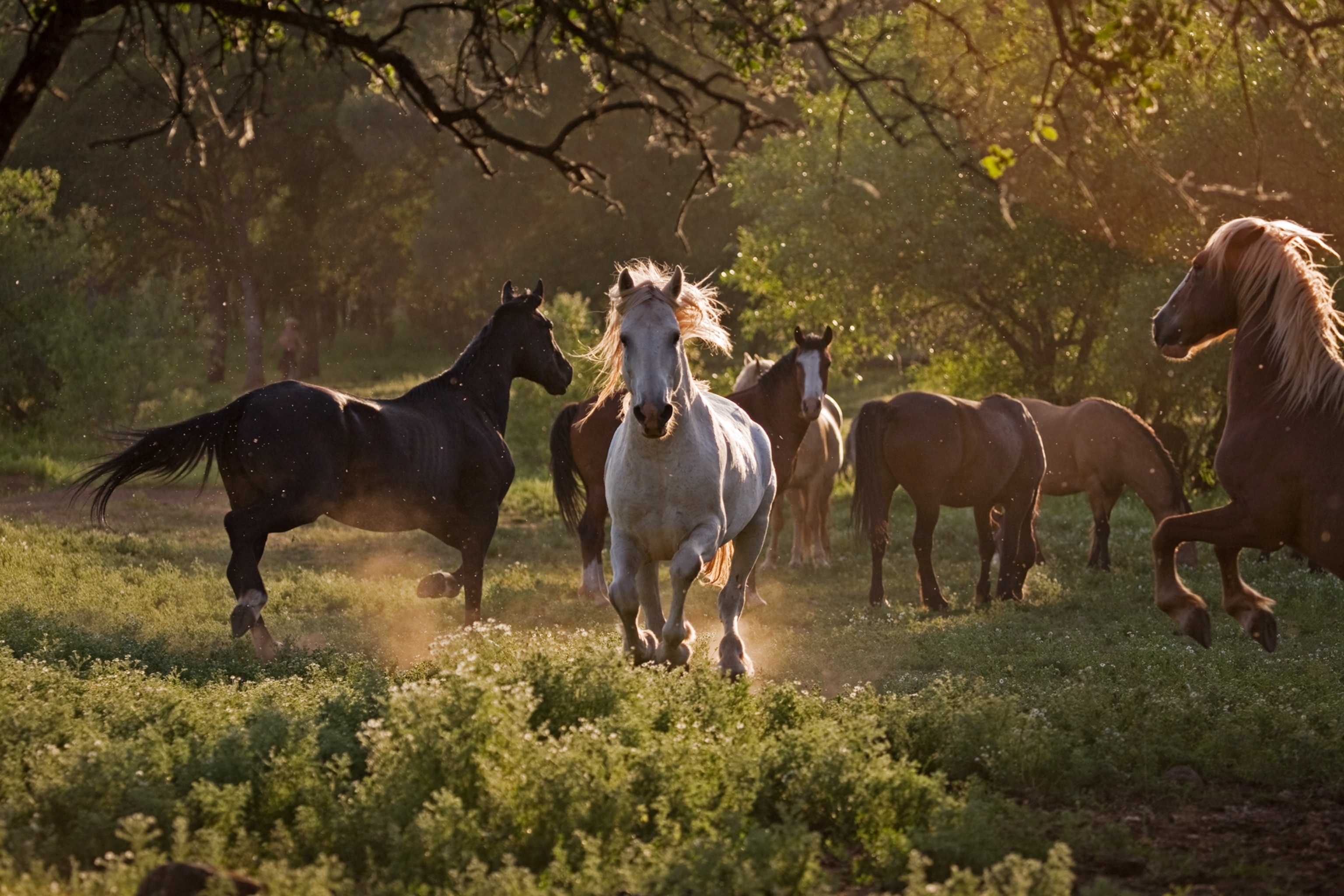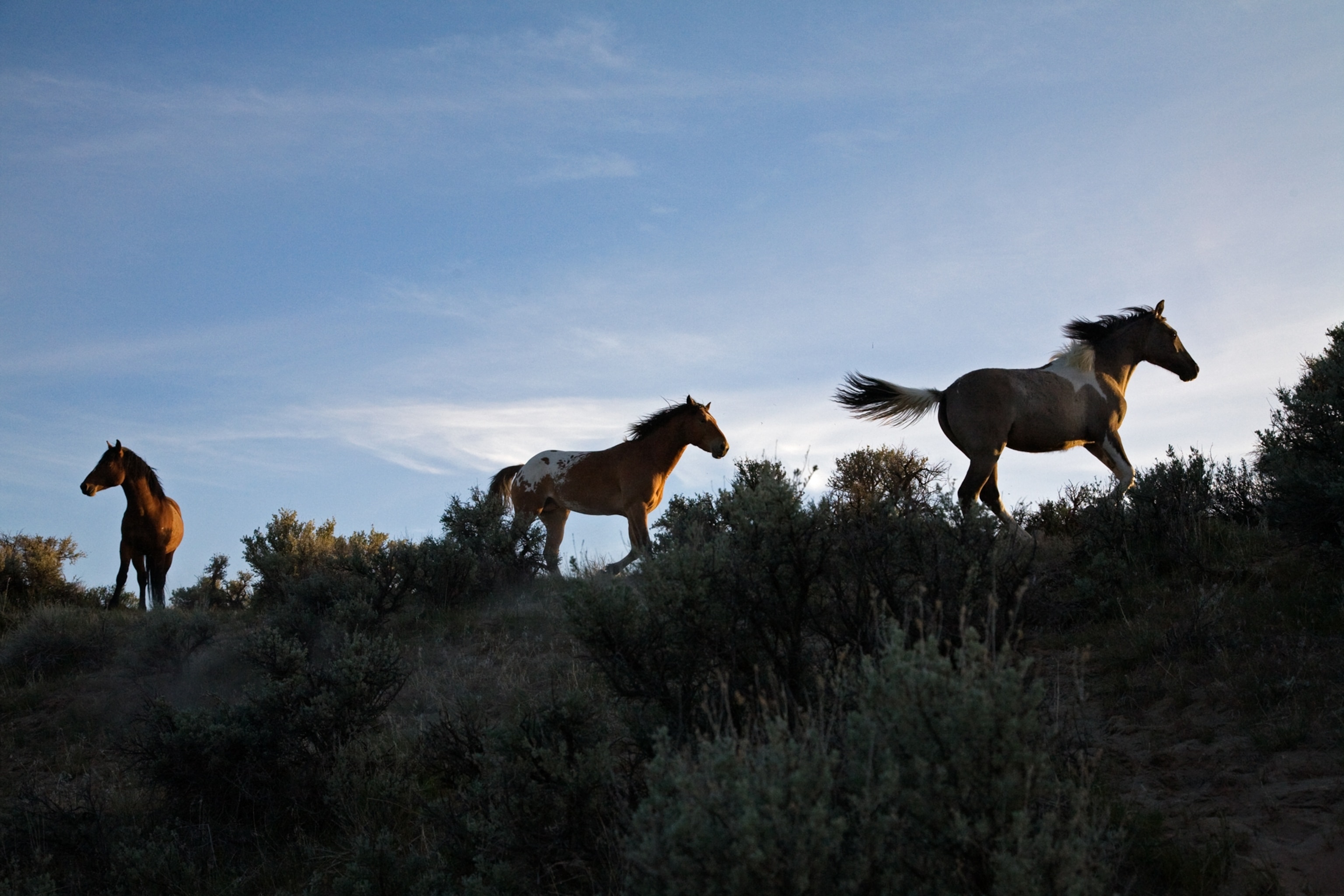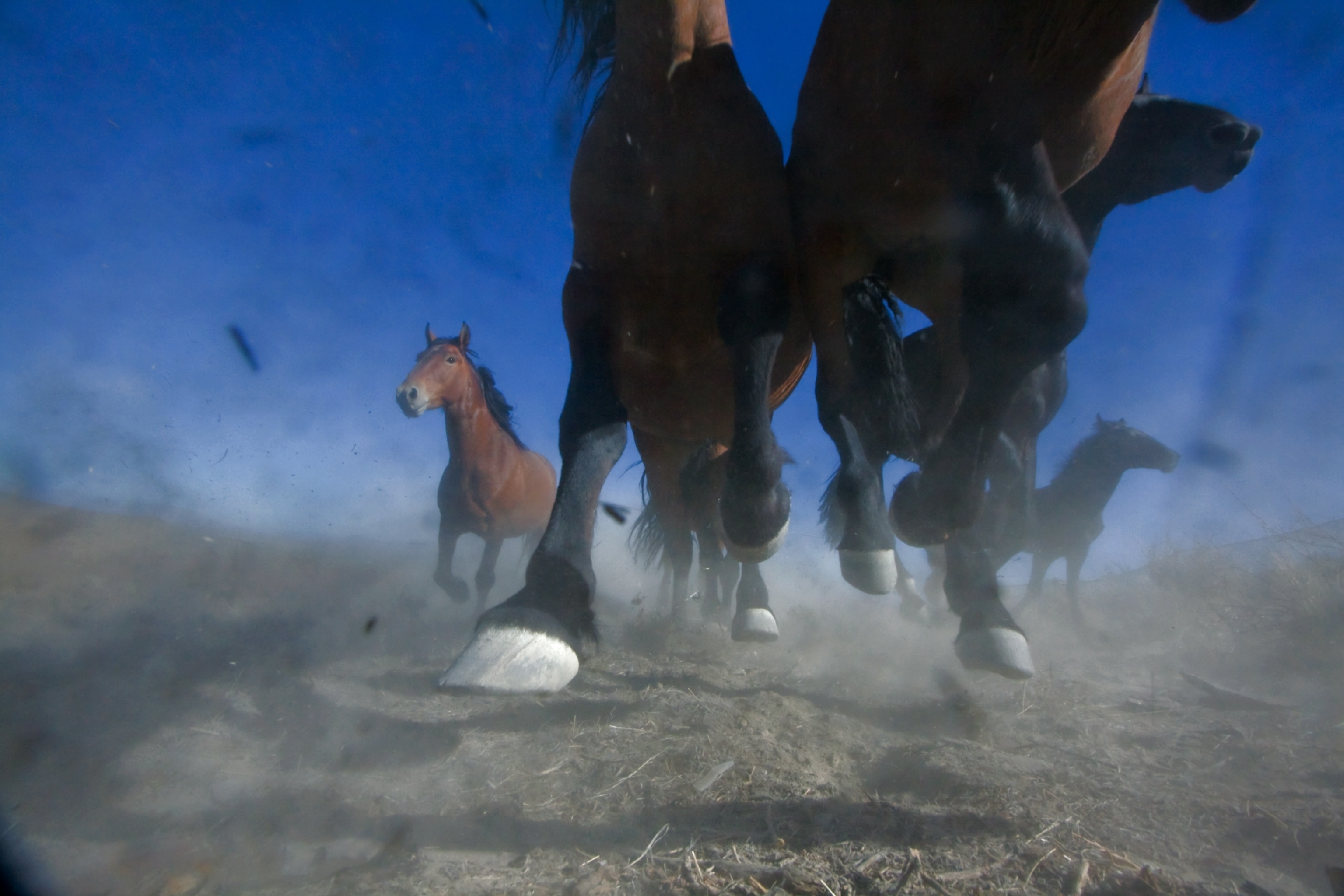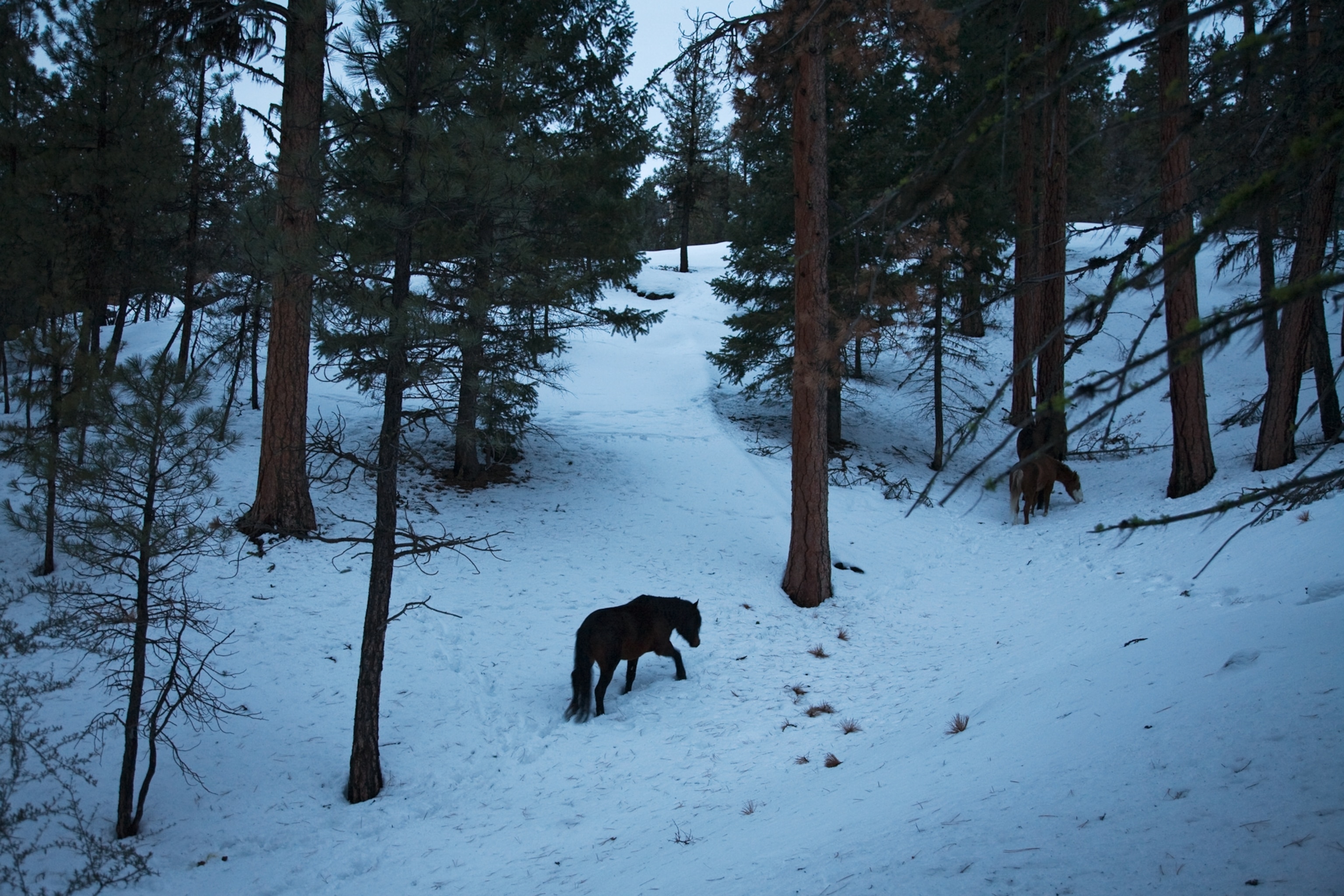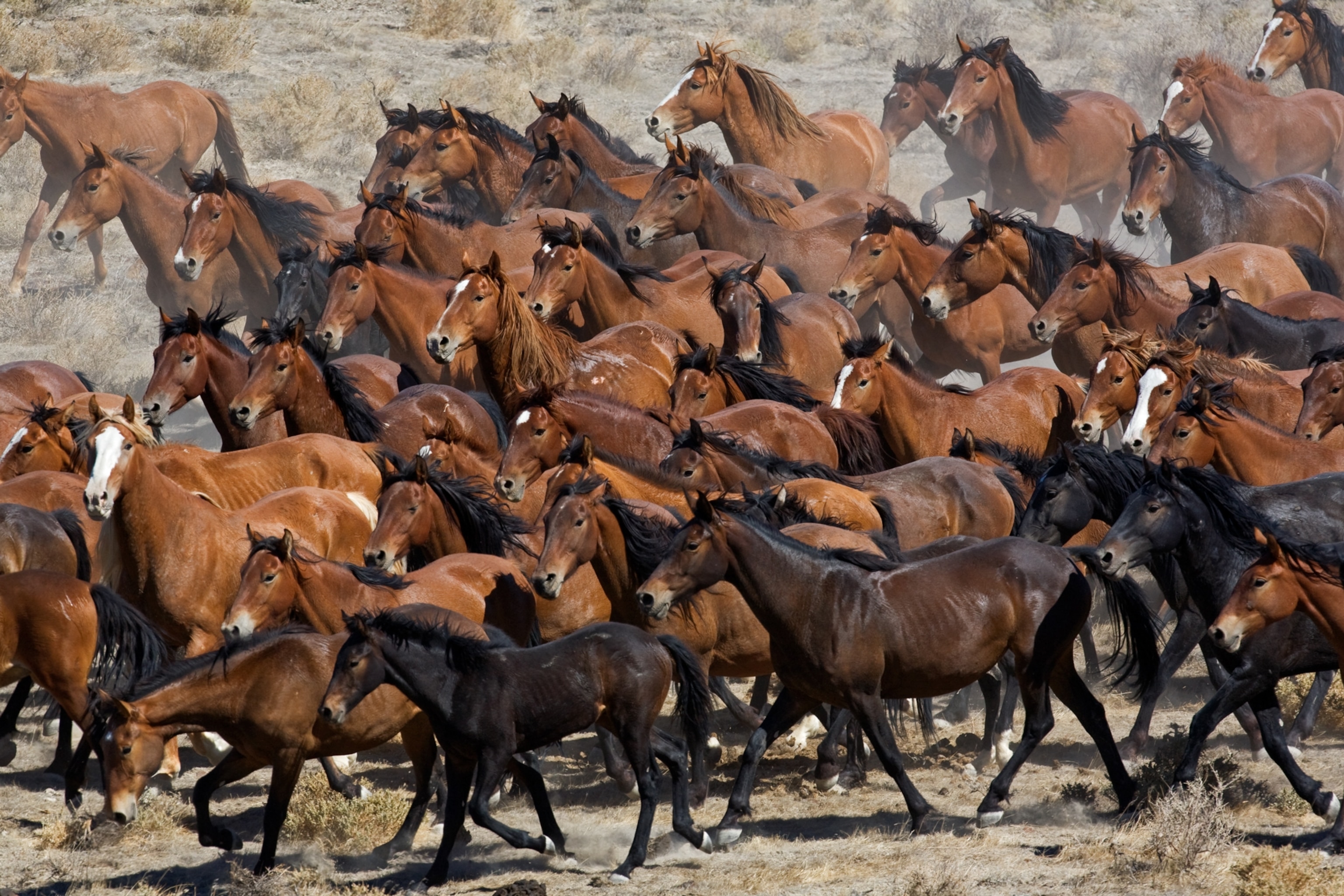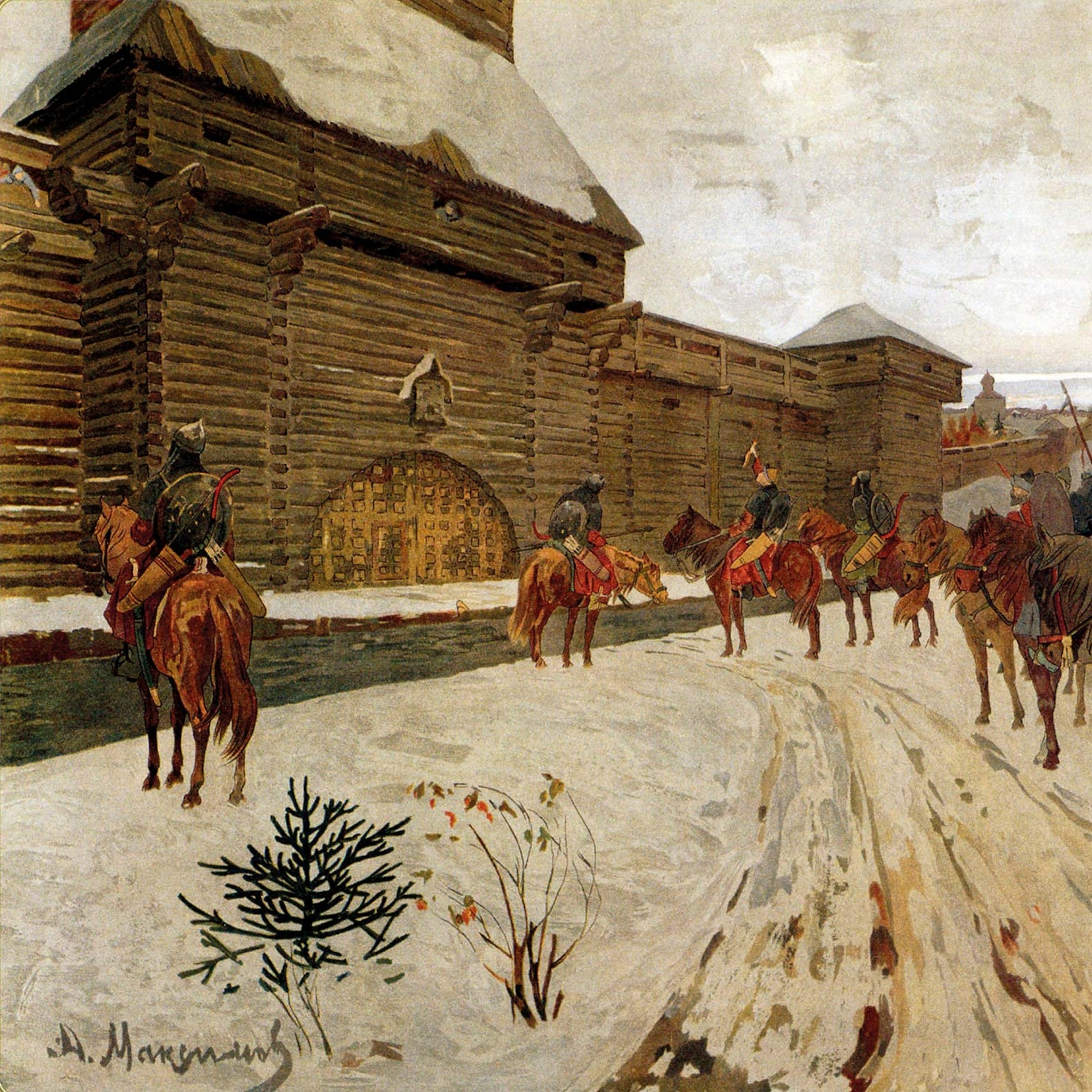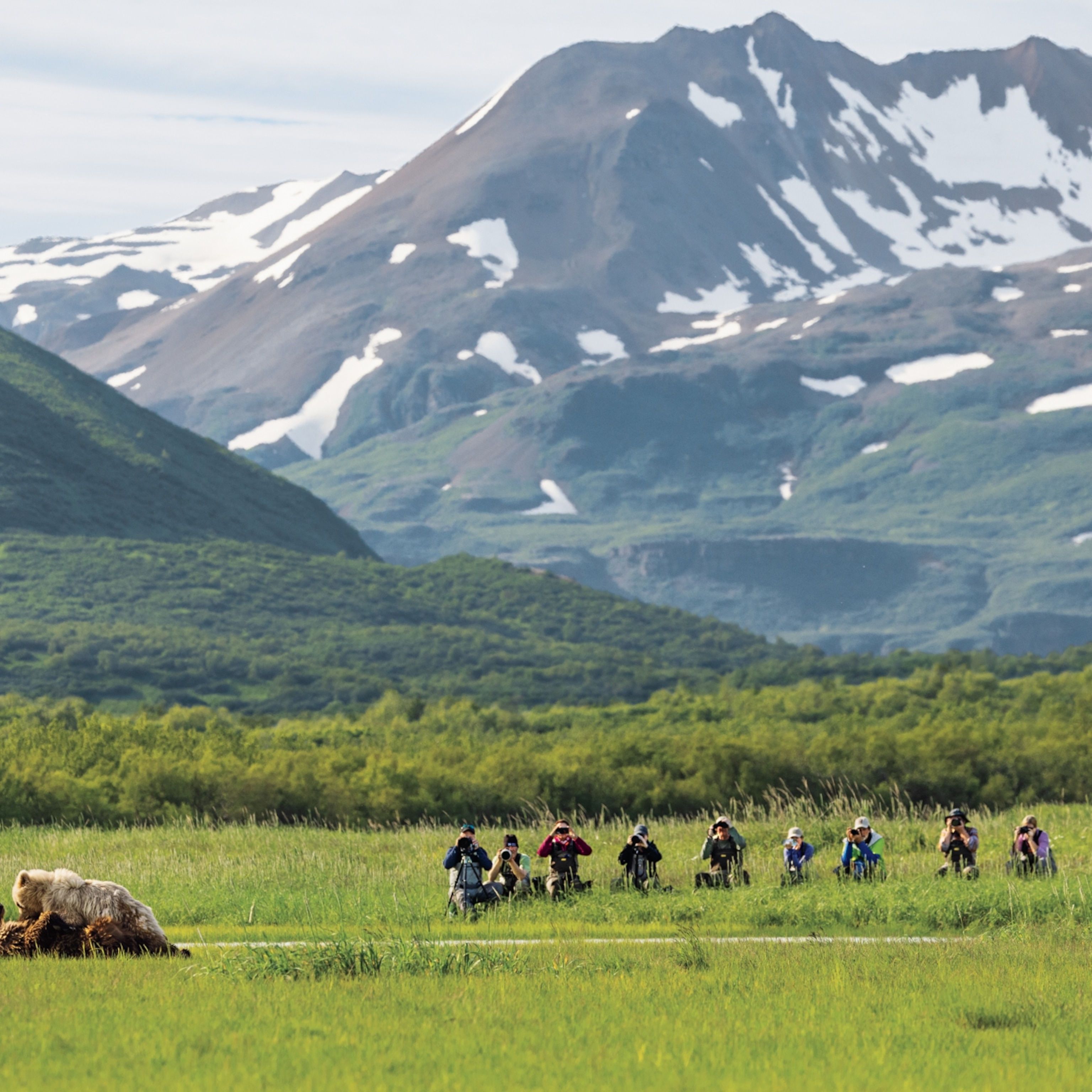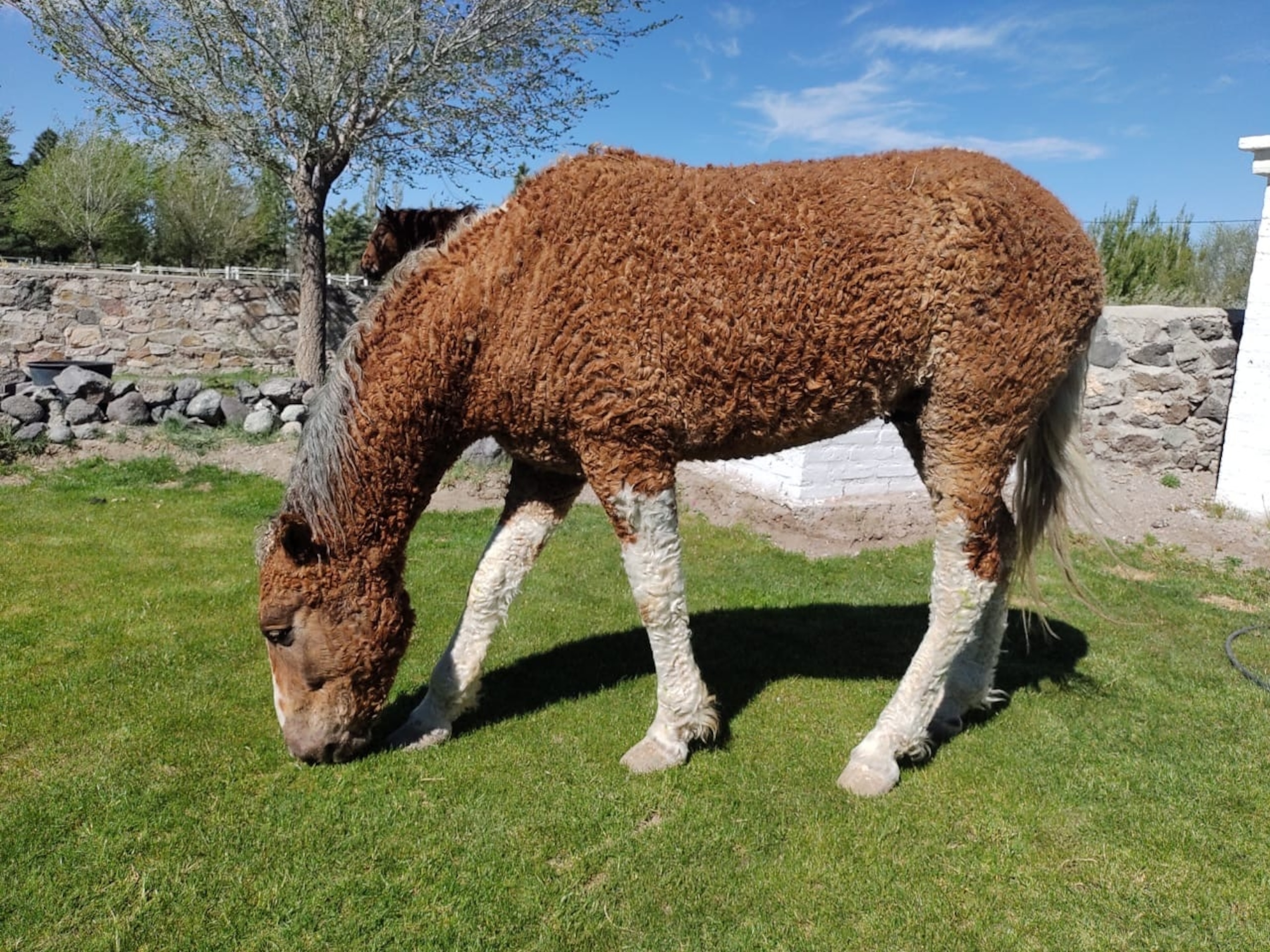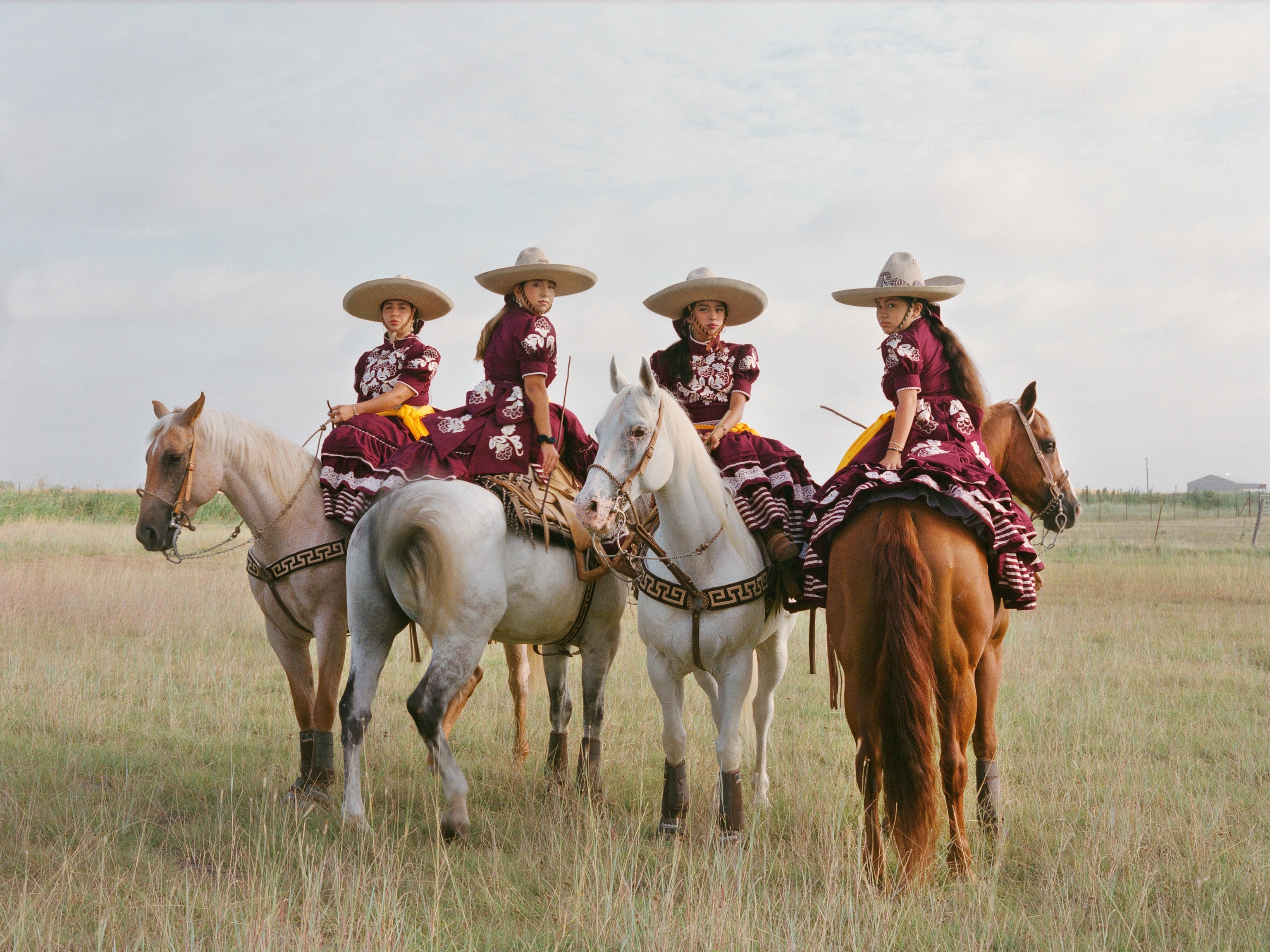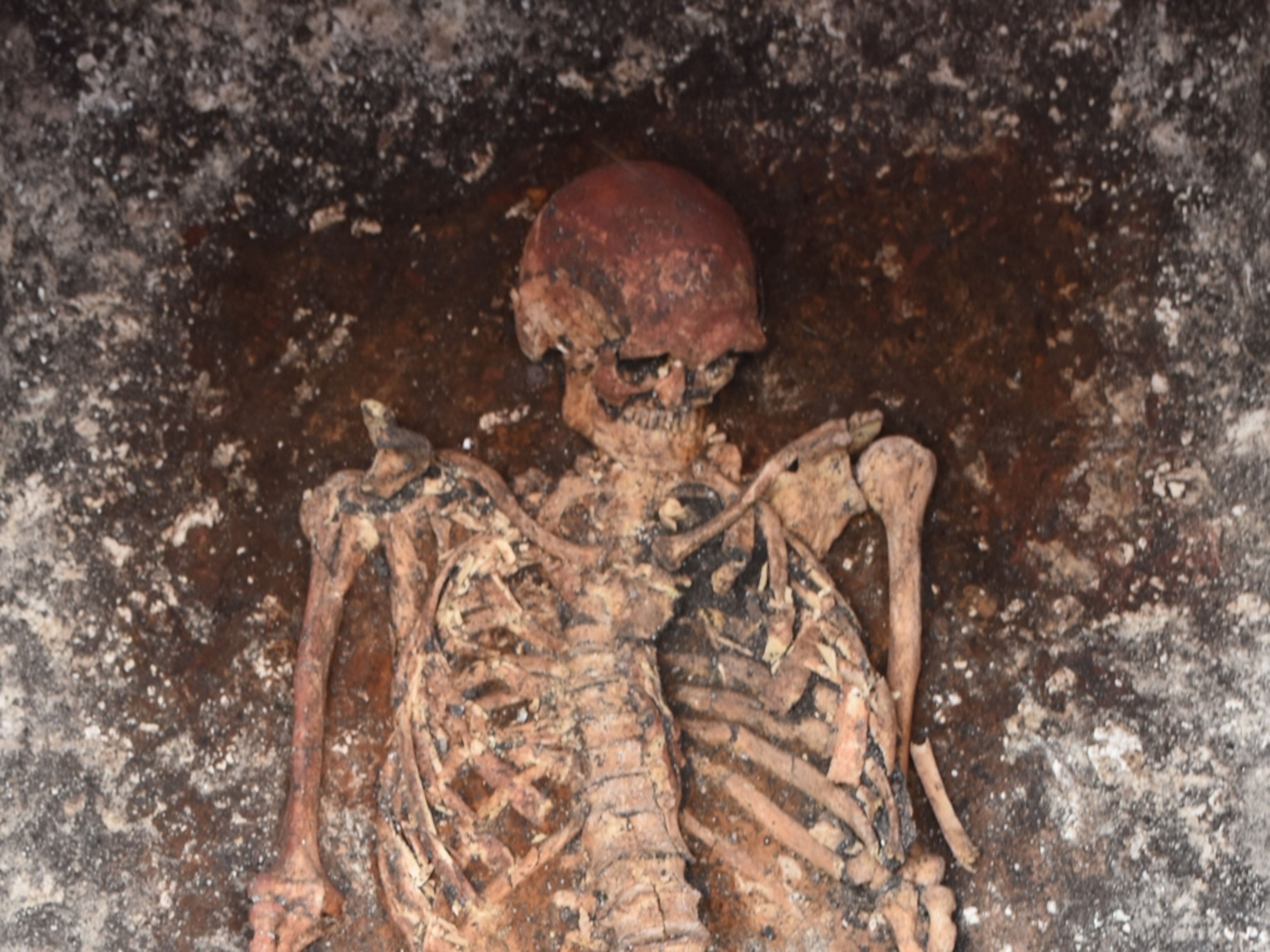Mustangs
Spirit of the Shrinking West
In the winter of 2005 Nelson Quispe, new from Peru to North America, was hired to herd sheep in Wyoming’s Red Desert. His sheep-rancher boss, Pat O’Toole, gave him a six-year-old mustang to help him cover the long miles over snow whales and sagebrush to open range. The mustang was white all over, with dark spots on his rear, betraying some Appaloosa in his ancestry, but with hooves like dinner plates, suggesting the additional introduction of something more along the lines of a draft horse. He'd been named Dot by the inmates at the Honor Farm near Riverton, where he'd been trained as a wild-born five-year-old. As a result the mustang had both native sense and correctional-facility manners, and you can do a lot worse than that in a horse.
O'Toole told the Peruvian, "If the wind picks up, and the sheep get blown out, just head back to your sheep camp. Whatever you do, don't try to follow them." He said this in both English and Spanish and, just to be sure, in gestures, because the way weather can turn on you in Wyoming, a man needs all the languages at his disposal to explain it. After that, a veteran herder of these ranges, also a Peruvian, gave the young man one short, critical piece of advice in Spanish. Then Quispe rode off with Dot and the sheep into the wide-open world.
He wasn't there very long before the wind turned to speeding metal sheets, and the temperature hit 35° below zero Fahrenheit. Quispe, full of youth's eagerness to prove itself, tried to stay with the flock. Then the sheep blustered off the range, and night fell, and the wind sped all the harder. The young shepherd was lost, frozen solid to his horse and sure he would die. Just then, however, he remembered the key piece of advice the veteran shepherd had given him. So Quispe leaned forward, took off Dot's bridle, and wrapped his arms around the mustang's neck. He closed his eyes and committed his soul to the Holy Mother.
Dot—whose ancestors roamed these plains roughly one and a half million years ago, and who was born wild onto this very land just six years earlier, and therefore knew this world to the millionth power—lowered his head to smell for prairie dog and badger holes to keep from falling and, compensating with brains and courage for what he lacked in beauty, took the terrified youngster right back to camp.
When the weather in Wyoming seems hell-bent on murder, and a shepherd can't see past his nose, the difference between life and death is—just as it used to be a century ago—a good, native-bred horse with more than a usual dose of backcountry smarts. But when the wind dies down, and cell phone service is restored, this modern age arrives with noisy, impatient abruptness, and wild horses look out of place in a West that is shrinking around them. So a straggle of mares and a few foals led by a single stud running parallel to a barbed-wire fence, power pylons, and an oil-field truck behind them is the way I first saw mustangs near Rock Springs late in the fall of 2007.
"Wild horses are right in the middle of a culture that wants nothing to do with them," said Jay Kirkpatrick, director of science and conservation biology at ZooMontana, in Billings, a center for the development of contraceptives for wildlife. Kirkpatrick, who has spent more than 30 years studying the animals, said the wild horse has been despised ever since white men came west—blamed for everything that can and does go wrong on these grasslands. So in the mid-1800s, when stockmen released up to 40 million cattle on the plains, where horses had lived for centuries without destroying the grazing, at most two million mustangs were held responsible for the suddenly depleted range.
At the same time, the range-tough wild horses, a fast-breeding renewable resource, were indispensable to early settlers. Occasionally hunted to keep their numbers in check, they were also rounded up periodically for ranch work and transport or were used to conquer and define the growing nation. Lt. Ulysses S. Grant, invading Mexico with Gen. Zachary Taylor's army in March 1846 on a freshly caught mustang (from mestengo, meaning "stray"), tells in a contemporary account: "As far as the eye could reach to our right, the herd extended. To the left, it extended equally. There was no estimating the number of animals in it."
But then came railroads and roads, cars and tractors, tanks and combine harvesters, and you can't fix a dead horse with a monkey wrench, so the mustang lost its value as transport and instead became, literally, dogmeat. Millions of pounds of wild horsemeat were processed into food for dogs, cats, and chickens during the 1930s alone. "Man," as Pat O'Toole said, "was the wild horses' natural predator."
Traditionally ranchers haven't had much time for anything that competes with them for resources. It's not uncommon to find coyote carcasses draped over barbed-wire fences, as if Westerners had gone trolling for whatever offended their souls and, unable to shoot the wind, turned their ire on something more tangible. In February 2006 the Sportsman's Warehouse in Reno, Nevada, sponsored a competition in which the varmint hunter who brought in the most proof—such as the jaws of coyotes, foxes, bobcats, and mountain lions—would win a boat. Around the same time several wild horses were also shot, even though mustangs have been federally protected since 1971—under the Wild Free-Roaming Horses and Burros Act—from capture, branding, harassment, or killing. (It was largely the efforts of a Nevadan, Velma Bronn Johnston, better known as Wild Horse Annie, to bring the plight of mustangs to public attention that led to passage of the act.)
You can outlaw cruelty, but you can't outlaw the culture that spawned that cruelty. Wild horses around the Rock Springs area (where Dot is from) have been killed in greater numbers than anywhere else in the country. It's impossible to know if the deaths are the deliberate work of ranchers fed up with the pressures on their grazing or of careless young men with too much time on their hands. In the spring of 2005 two Wyoming men and two men from Utah roped a wild stallion and castrated the animal with a knife. The mustang bled to death, and its body was dragged to a remote draw and left to rot. All four men were apprehended, convicted of misdemeanors, given six-month suspended jail sentences, and ordered to pay fines of a little more than a thousand dollars each.
It's hard to conceive that anyone would kill a federally protected mustang in this way, until you take into account the anatomy of the West: little towns strung like beads along highways, and between the towns an impression of endless public lands where it's still possible to imagine getting away with anything, in part because these expanses feel as if they belong to no one and everyone all at once.
In the ten Western states where wild horses are found, the federal agency in the unenviable position of overseeing the interests competing for public lands—livestock and minerals, trees and the people who hug them, hikers and wildlife, wild horses and watersheds—is the Bureau of Land Management. The BLM is required to manage its 258 million acres (more than any other federal agency) for an ever changing West and for "multiple use." In theory there should be enough room for everything, but in reality, from the moment pioneers settled here, resources have been extracted with little patience for anything that got in the way of a silver dollar. These are not—and never were—lands managed for all things equally, but for the priorities of the age.
Historically the priority has been livestock, and in 2006 cattle and sheep consumed 20 times as much forage on BLM land as wild horses and burros. But in the past 30 years the tone of the culture has been changing. Ranchers in many parts of the West have been losing their dominant place, and the loudest voice is now coming from oil companies. With intensifying pressure to make the United States more energy independent, the BLM has leased 44 million acres of land for oil and gas, nearly five million of that in areas set aside for wild horses. It's an indelible use of the land: Even when capped, the wells don't go away.
"The energy is where you find it," said Tom Gorey, PR officer for the BLM's wild horse program. He sounded profoundly reconciled to that fact.
Gorey's agency oversees some 30,000 wild horses, which are confined to 29 million acres of disconnected BLM herd management areas (HMAs). Under the 1971 act the BLM must keep the herds at what it decides are appropriate management levels (AMLs). Some horse advocates believe the AMLs are arbitrarily low, threatening the genetic viability of the herds; ranchers say they're unrealistically high, threatening vital grazing.
Pat O'Toole's grazing allotments (an allotment is an area of BLM land leased to stockmen) overlap with HMAs in south-central Wyoming and northwestern Colorado, and he has the measured calm and authority of a man who has learned his priorities the hard way. "When the wild horses were regularly harvested by ranchers," he said, "they couldn't take the range down. Then the wild horse was protected, and the ability to control their numbers was taken out of the ranchers' hands—and now there's just too many of them." He thought for a moment. "We've had a ten-year drought. Then add to that, oil and gas development is putting inconceivable pressure on the public land, and then consider that the wild horses have already taken the grassland to nothing. It's hard on everyone—the wild horses, the ranchers, the wildlife, everyone." But even as O'Toole spoke about his frustration at wild horses' appetites, he defended their right to exist as a symbol. "Wild horses have their place on the range," he said, "but when they've eaten themselves onto bare dirt, it's hard to feel that they're being appropriately managed."
Jay Kirkpatrick of ZooMontana agreed that wild horses "can exceed carrying capacity in places and cause problems not only for livestock and wildlife but for themselves. But," he said, "the key to understanding why wild horses are the scapegoat for poor land management and worse politics is that, unlike huntable wildlife and livestock, they have no economic value."
So the argument about wild horses and the resources they use comes down to this question: Do we have the landscape—physical and emotional—for them? While horse advocates and stockmen often argue the relative merits and demerits of the mustang on more emotional grounds, scientists are arguing on the basis of a fundamental fact: If the horses can be classified as native to North America, they have a right to the use of the land. If they're not native, they don't.
"Free-roaming horses are a feral, exotic species," said Joel Berger, a wildlife biologist based in Teton Valley, Idaho. "They're in direct competition for habitat with native wildlife." Berger suggested that the BLM's budget for wild horses might be better spent on the study and protection of native species. But Kirkpatrick and his sometime collaborator Patricia Fazio, an environmental writer, have long asserted that the wild horse is a native species and should be regarded as such by state and federal agencies. "Modern horses evolved on this continent 1.6 million years ago, only to later disappear," Kirkpatrick told me. "The two key elements for classifying an animal as a native species are where it originated and whether it coevolved with its habitat. The horse can lay claim to doing both in North America."
Although scientists differ on where today's horse, Equus caballus,arose, it is agreed that early members of the genus Equus appeared in North America some five million years ago. Some of them wandered across the Bering land bridge and spread into Asia (where they were eventually domesticated), Africa, and Europe. But these horses disappeared from their North American cradle about 12,000 years ago. One theory is that Pleistocene man, entering the continent around that time, hunted the horse to extinction. Other scientists theorize that a virulent disease, or perhaps a combination of climate change, disease, and hunting, wiped out the horse. In 1519 horses were brought to the North American mainland when Hernán Cortés arrived in Mexico. Some scientists argue that the Spanish conquistadores' horses encountered and bred with a remnant native population, but there's no proof of this.
Some herds are direct descendants of those brought by the conquistadores, notably the Pryor Mountain herd in Montana and northern Wyoming, whose centuries-old Spanish heritage was established through blood tests in 1992. These horses tend toward more primitive, exotically wild markings—they have zebra stripes on their legs and lines down their spines, and they come in camouflaging shades of dun and charcoal.
But nearly all wild horses in the West are like Dot, the mustang that saved the Peruvian shepherd. They're a mixture of breeds that made it out onto the range over the centuries (many during the Great Depression), their stock enhanced by deliberately released draft, Thoroughbred, Morgan, and Arabian stallions, with the weaknesses of each pureblood salted out of it and the instinct for survival whetted with each successive generation.
Midmorning in early November I was hunkered down on a butte near Rock Springs, northwest of where the BLM had caught Dot, to watch horses being rounded up. "Don't move, don't talk," I'd been warned, "or the horses might startle away from the corrals." Wild horses are acutely attuned to dangers in their environment, chief among them humans. I tucked my chin against my chest and folded my arms. The ever restless Wyoming wind was loaded with winter intentions, and the water in the troughs in the corrals below had frozen inches thick.
A helicopter pilot contracted by the BLM swept out across the plains, herding groups of horses into a canyon below us. The canyon shrank into a camouflaged burlap chase, at the mouth of which a "Judas" horse was released, leading its wild cousins into a metal corral, where yesterday's wild horse catch was already waiting. At the gate, the pilot tipped his blades at a few balking horses, which shocked forward into the cloud of dust. The gate was slammed shut, and a handful of young cowboys, quick as cats, spilled over the fences into the midst of the herd. The helicopter went back out for more horses. Inside the corral the cowboys separated the stallions from the mares, the foals from all the others. Within an hour 40 to 50 horses had been skillfully processed.
The horses' panic subsided to what looked to be anxious resignation. A vet hovered near the corrals, inspecting each horse. A few had sustained superficial injuries, but none appeared seriously hurt, although wild horses are sometimes injured or killed during gathers.
Every year 40 to 60 gathers remove between 5,000 and 10,000 wild horses from the western range. Over nine days at Rock Springs, more than 600 horses were brought in, then trucked to Cañon City, Colorado, to a prison where they were branded, gelded, doctored, and sorted by gender and age. Some would be trained by inmates for auction later in the season; others would await adoption or removal to long-term sanctuaries.
"I'm not a bunny hugger," Jay Kirkpatrick told me, "but I'll never attend another gather as long as I live. They're flat-out inhumane." He paused: "There are three reasons why these gathers are an unsatisfactory solution to the problem of numbers. Firstly, it's genetically irresponsible to be constantly pulling off young horses whose genes will never get expressed; secondly, every time you pull horses out, the reproductive efficiency of the horses that remain increases. And thirdly, the behavioral consequences for the horses are profound."
Jay D'Ewart, a BLM wild horse specialist in Rock Springs, Wyoming, said he doesn't like to see the mustangs rounded up either, but that his agency is responsible not only for the welfare of the horses but also of the range. "We can't leave horses out there to breed themselves into starvation and ruin the range for wild horses, wildlife, and livestock. We have a duty to ensure balance. So we gather with helicopters, as quietly and quickly as we can."
Limited by the carrying capacity of the land and tugged between the demands of ranchers, miners, and hunters on the one hand and the indignation of wild horse advocacy groups on the other, the BLM has settled on keeping 30,000 horses in permanent captivity (about as many as exist in the wild) at an average daily cost of more than two dollars each. This arrangement soaks up funds and provides, at best, a stopgap solution to the animals' tendencies toward prolific breeding. Every year thousands more horses are rounded up, and every year thousands more end up in long-term holding.
Last year the agency said it might have to euthanize horses to reduce costs (which prompted Madeleine Pickens, T. Boone Pickens's wife, to offer to adopt many, if not all, of the BLM's captive mustangs). "Everyone could see this coming," said Chris Heyde of the Animal Welfare Institute in Washington, D.C. "Every year they pull more and more horses off the range to keep the ranchers happy. Meantime the scenario for the horses is just awful."
"The more we know about the emotional and social lives of horses, the more we realize that they draw on a powerful collective wisdom," said Ginger Kathrens, as she pointed her camera at a band of mustangs on a ridge just beyond us. "They live in highly structured, hard-won family groups. If you arbitrarily pull horses out of that group, the consequences can be devastating for the remaining family members."
Kathrens is a documentary filmmaker who has been observing wild horses for more than a decade in the Pryor Mountains. She's made two films about these 170 horses and was working on a third.
It was a raw spring day, and we settled down with our backs to the wind and watched. A pale stallion named Cloud was keeping half an eye on his mares as they grazed the range on top of this rocky ridge and half an eye on us. Kathrens said that a stallion will fight—sometimes to the death—for the right to own mares, which he must then continue to defend from interloping bachelors until old age makes it impossible for him to carry on. As Kathrens described Cloud's relationship to his own mares and then to his father, his mother, his brothers, and half brothers, she wove a storyteller's tale of intrigue and interfamily squabbling, of unlikely alliances and terrible, sudden wars. There was even a case of what might be called love—a solitary and now elderly couple that broke the rules of wild horse society to be together. When the stallion that had won the mare let her out of his sight the night she was foaling, she escaped and sneaked back to her stallion of choice. "In some cases," Kathrens said, "I've seen a stallion lose his mares in a BLM gather, and for that stallion, who has fought life-threatening battles for those mares, his life is over. He'll end up on his own, and I don't think it's too strong to say that some stallions succumb to a form of depression."
Kirkpatrick said contraception offers a humane alternative to rounding up the animals, but that the BLM is resistant. He said the agency is spending too little studying fertility control and too much on helicopter roundups. When he suggested to a BLM official that the agency inject the mares with the wildlife contraceptive vaccine porcine zona pellucida (PZP), he recalled being told, "That's not how we do it out here. We do it with horses and ropes." According to Tom Gorey, the BLM spokesman, PZP has been administered on an experimental basis to about 1,800 mares since 2004. "The effects on population growth are being monitored," he said.
Kathrens is wary of any kind of human intervention to manage herd numbers. As we were speaking, a thin, charcoal-colored mare lay down next to her foal. Kathrens explained that the mare had been vaccinated nearly seven years earlier with PZP. When it wore off six years later, she conceived out of season. The foal had been born in September, too close to the onset of winter to allow either animal to meet a cold, snowy spring in anything close to decent condition. Kathrens told me that out of season births have been a sad side effect of PZP on the Pryor mares, an observation adamantly rejected by Kirkpatrick, who says that there are always some out of season births, with or without PZP. Kathrens turned the camera on the mare, whose head was now flat on the ground. The foal nudged its mother. "Oh, look at that," Kathrens exclaimed. "If this weather keeps up, I don't know if this pair will make it into summer alive."
When I asked Kathrens what she considered the best alternative to either gathers or PZP, she was adamant: "Nature. Natural selection by mountain lions, exposure, starvation. It may sound harsh to say, Let nature take its course, but it works. The health of the overall herd is far stronger when nature decides who stays in the herd and who doesn't, rather than humans making those kind of decisions."
Kathrens owns one Pryor-bred wild horse and anticipates making room for more. Roughly 5,000 wild horses go to private homes every year through the BLM adoption process. (Pat O'Toole has adopted eight, including Dot.) Of those, at least 500 end up in equine rescue centers or at auctions. There they risk being sold to "kill buyers," who sell the animals to slaughterhouses. Although the adoption agreement discourages owners from unloading their mustangs for slaughter, the BLM has no legal way to prevent it. Inexperienced owners overwhelmed by the wild horses' powerful survival instinct or by the very real cost of owning a mythical part of the Old West sometimes end up sending their mustangs to auction, desperate to be rid of such trouble.
Few people adopt horses and then sell them to slaughter purely for profit. But it does happen. In 2005 an Oklahoma man who said he wanted wild horses for a church youth program adopted half a dozen for $50 each and sold them to an Illinois slaughterhouse for a small profit.
Two years later the U.S. Court of Appeals for the Seventh Circuit upheld the decision by Illinois to ban the slaughter of horses for human consumption, and the last slaughterhouse in the country closed down. An unintended consequence of the new law is that more horses than ever before are being sent to slaughter in Canada and Mexico, and there is no way of telling how many of those animals, exported in crowded trailers, are former wild horses. "I can't see brands," a U.S. Department of Agriculture employee told me under condition of anonymity. "I'm just counting bodies. It's hard enough to figure out what gender the horses are, let alone what breed."
The way Pat O'Toole tells it, Nelson Quispe herded sheep again for him in the winter of 2006. Naturally the young shepherd insisted on riding Dot. For one person at least, the unholy terror of a Wyoming winter storm had transformed the wild horse from a symbol of nobility and survival to the actual beating heart of all that those words imply. But O'Toole didn't have time to ponder the romance of the story. "I don't know if we can carry on running sheep," he told me. "We've been through tough times before, but this is as tough as I've ever seen it." There was a long pause in which both of us contemplated what he faced—the squeeze on land from oil and gas development, competition for range with wild horses, drought, and the skyrocketing price of feed. And then we talked about what would be lost if O'Toole were to close down his operation: sheep, the rancher's stewardship of the open range, a use for the wild horse.
Horses will likely be around as long as there are humans to attach themselves to a saddle. What is less sure is whether there will always be enough wild to allow mustangs to run in secure, functional, genetically viable herds. Driving home from the Rock Springs gather, through Pinedale to Jackson, I'd seen acres of the High Plains turned over to oil and gas development, rigs towering out of the frozen sage, the outskirts of towns bristling with man camps and trailer parks for the roughnecks. Oil field traffic hurried out on a web of roads, seeming to skim along on a silver-rimmed mirage. Roadkill, mostly pronghorn and mule deer, lay bleaching on the verges in unprecedented numbers.
Until maybe 20 years ago there used to be a herd of wild horses out here too, kicking around the edges of town in the spring and getting rounded up periodically by local ranchers. No one I spoke to could remember the exact moment they disappeared.
